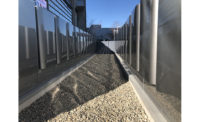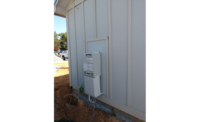
figure
1.
Energy saved from a full year of electricity and gas in
2003 vs. 2008.
A large modern-day sporting complex includes tens of thousands of seats and what seems like almost as many types of spaces and functions. For the facility staff at the New England Patriots’ home, there is no off-season as they tackle this head-spinning challenge. See how energy conservation has stayed in the game plan, from original design process to post-occupancy staffing.
U.S. Route 1 starts as you enter Van Buren, ME near the Canadian border and ends in Key West, FL. Early into the trip, heading south on this historic Route 1, you can’t help but be impressed as you drive pass Gillette Stadium, just outside of Boston in Foxboro, MA. From the road one may say, “Wow, that’s home of the three-time Super Bowl champion New England Patriots.” It is not obvious to the naked eye that this mega-structure is more than just another NFL stadium. It’s also not obvious to HVAC design engineers. For the operations group at Gillette Stadium, it is a 24-hr a day, 365-days a year O&M success story that takes on HVAC support service challenges for a wide range of space applications.
One might not think the stadium is anything more than a NFL team’s home field that may host an outdoor concert every once in a while in the summer, but Gillette Stadium is probably the flagship for new multi-entertainment venues. Built in 2002, it continues to be the standard for NFL complexes because of the Kraft Group-A Family of Businesses enterprise (www.thekraftgroup.com).
What is not obvious from the parking lot is the all-encompassing setting for private businesses, such as International Forest Products and the New England Revolution Major League Soccer (MLS) team, to mention just two enterprises owned by The Kraft Group. This facility is a combination of entertainment complex meshed tightly together with a business community.
As you look closer, you see that the bridge that connects the stadium’s east side to its west side mirrors the Longfellow Bridge that connects historic Boston with its equally historic neighbor, Cambridge, MA. A second symbol of this unique facility is the 12-story lighthouse overlooking the end zone. Three concourses (each 70 ft wide, open to the playing field and enclosed around the outer perimeter by a wide range of concessions stops) provide an open-air atmosphere welcoming its visitors.
A Facility Management Challenge
Bridging entertainment with business, this multi-use complex has two clubhouses looking out onto the field with a capacity for 3,000 guests each as well as 2,000 luxury suite seats and can be leased on a daily basis throughout the year.Another shared investment is the 84 luxury suites that offer fans the opportunity to use their suites on a regular basis for their own business needs. The year-round work venue within this facility, houses over 60,000 sq ft of office space that headquarters The Kraft Group, as well as the New England Patriots operations and the New England Revolution Soccer operations.
Adjacent to the stadium is the 84,000 indoor training facilities which serve multiple roles including the home of the Gillette Stadium Expo Center, as well as the new mega-Patriot Place that provides a wide range of retail, entertainment, hotel, and health care facilities that draw people to Foxboro on a daily basis.
This entrepreneurial venture officially opened at the start of the 2002-2003 NFL season and continues to grow today. The facility management organization has demonstrated from the onset that it could keep pace with the business demands and challenges at the stadium with the first challenge being able to reassess, reprogram, and reorganize the complex HVAC infrastructure based on lessons learned. For design engineers, there are lessons to be learned from these 21st-century multi-use sites too. There are not a lot of design guidelines for HVAC engineers to reference for a facility of this type. Like so many business ventures, when this stadium was designed and built, it was based on a strategic business plan to be financially successful. Good O&M needs to be proactive, cost effective, and efficient, with a concern for the future. Design engineers need to communicate and learn from facility management what the day-to-day issues are, so they can design HVAC systems to accommodate the demands put on the facility management staff.
At this stadium, the operations group strives to mirror its client’s management approach by also striving to be business savvy, so that it was contributing to providing a safe and healthy environment and be as energy-efficient as possible. As a result, this support service group didn’t wait long after occupancy to begin to enhance the building systems beginning with an organization structure assessment and a preliminary energy audit to identify the site’s facility management status as well as what would potentially be needed to keep pace with the stadium’s growing business venture.
At Gillette Stadium, the magnitude of space/application diversity would provide an interesting challenge for the facility engineering group, and the consultants they drew upon for assistance. The multiplicity of mechanical, electrical, and building management design intent/requirements are broken out as follows:
- Field-level activities with 24-7 operating demands:
- NFL operations (in-season, off-season, and pre-season)
- MLS operations (in-season, off-season, and pre-season)
- Full service food and beverage operation and kitchens
- Warehouse
- Security
- Facility and ground crew operations

FIGURE 2. Natural gas consumption in 2003 vs. 2008.
- Administration level with more traditional office-hour operation requirements:
- New England Patriots administration
- New England Revolution administration
- Stadium operations management
- Kraft Sports Productions
- The Kraft Group
- International Forest Products
- Construction administration services
- Club level with seven-day leased daily functions over 200 days a year:
- East and West Club area
- Kitchen support space
- Corporate meeting space
- Main concourse with game day and night-time football and soccer and concert functions:
- Food vendor area
- Seating sections
- TV, radio and news area
- Lower-level luxury suites level with potential for seven-day, individual space use:
- 42 luxury suites
- Press area
- Upper-level luxury suites level with potential for seven day, individual space use:
- 42 luxury suites
- Press area
- Scoreboard and display board operation
- Sports lighting level, with NFL and TV peak energy demands on game day
- Adjacent areas (pro shop, boiler/chiller plant, emergency generators, etc.) and their individual space requirements
Lessons Learned and Energy Conservation
For engineering firms that design multi-use buildings, the initial mechanical and electrical design intent needs to accommodate space usage flexibility, as well as a variety of operating hours, 365-days a year. Sport-entertainment-business complexes, such as Gillette Stadium will challenge the best and most creative engineering expertise based on operating parameters that change to meet a diverse range of use and peak demands on the mechanical and electrical systems. ASHRAE recognized this engineering issue and presented seminars on the topic at the 2009 Annual Conference in Louisville this past June because of the popularity of these new, multiple-entertainment venues and the need to learn from those complexes that have been built since 2000.Once a mega-facility is completed, energy cost control and the ability to minimize equipment on-line while maximizing useful equipment service life becomes the responsibility of groups like this stadium’s O&M personnel. At Gillette Stadium, the organization has been able to reduce overall energy consumption from 31 to 24 MkW, a 23% reduction in electrical energy by aggressively managing the building systems. From a sustainability point of view, that represents 5,000 metric tons of carbon dioxide, which is equivalent to heating approximately 470 homes a year. The energy lessons learned have provided the electrical data found in Figure 1.
The electrical demands can be significant based on whether it is a regular office day in the summer, in the winter, on a MLS game day, the night of a concert, or an NFL game day:
- Regular office day: 2,500 kW
- MLS game day: 4,500 kW
- Stadium concert: 5,500 kW
- NFL game day: 9,500 kW
Dedicated BAS Manager
With the amount of energy used, the stadium invested in a third-party utility provider to procure the most cost-effective energy, and in sync with this purchase they continue to fine tune the day-to-day operation of the building systems. In addition, a new position was created within the O&M group: BAS manager. This individual brings added value to the lessons learned by focusing solely on energy management and keeping the BAS fine-tuned.So often BAS computerized installations are designed to play a critical O&M management role when building programs move from design to construction to occupancy and yet they more often than not are left in cruise control by the owner’s facility management group. It has been said that while O&M personnel will cost the owner money performing their duties (keeping systems running and providing space comfort), a BAS manager or BAS technician is the one person on staff who can save money by doing his job. At Gillette Stadium the BAS person’s responsibilities are:
- Maximize the capability of BAS through scheduling/zoning, set back and demand limiting programming
- Program global occupied and unoccupied setpoints and standards
- Optimize warm up durations/timing to obtain space setpoint standards
- Increase system and sub system viability through graphics development and implementation what’s visible gets attention
- Review and adjust operation of all systems and equipment by field verification of balanced reports, zone controls
- Central air-handling systems
- Rooftop AHUs
- Fancoil units
- Terminal equipment (VAV and VAV with terminal heating coils)
- General exhaust and specialized exhaust systems
- Central gas-fired hot water heating plant (primary and secondary pumping system)
- Hot water heating (water-to-water heat exchanger serving the field heating system)
- Domestic hot water heating system (with indirect storage)
- Central air cooled chilled water plant (primary and secondary pumping system)
CMMS System
Integral to the long term success of any building system infrastructure is the implementation of a CMMS system. At the time this stadium complex was opening its gates to the public, Kraft invested in collecting the mechanical and electrical assets as well as barcoding this equipment and panels for input into their CMMS system. This equipment information was used to build out the CMMS database, implement PM schedules, and develop a site labor model, which was used as the staffing program. Along with this hardware and software investment, the stadium management outlined an O&M staff structure to accommodate the demands that go with support services and fit within the full-time employee range. This organization structure was benchmarked to other NFL stadiums in the process. With the diversity of functions occurring along with the day-to-day activities, the support staff provides shift coverage on a weekly basis.Summary
So, even HVAC design engineers who drive down Route 1 and turn into the Gillette Stadium would probably be surprised at the technical success of the stadium’s facility support services group, who have taken a good design and made it a more sustainable operation.In hindsight, designing and operating a multi-entertainment venue offers several challenges beyond other projects that may have diversity of operating hours but not the diversity of these 21st-century mega-stadiums. For the designer, the challenge is capturing the diversity of application, design parameters, hours of occupancy, and then coming up with the optimum HVAC systems to accommodate the diversity of needs placed on the facility manager in an efficient and cost effective manner.
From a facility management point of view, the challenge is to understand and meet the requirements of being a corporate headquarters, exposition, and business function and sports/entertainment operation all rolled up into one building, ensuring a balance of efficiency and effective staffing levels. Most modern stadiums are not used for game/event business only, but they are continually evolving and merging into a seven day/week sports and entertainment venue, as well as housing corporate management for these ventures and other private industry business ventures. The cost of construction prohibits a stadium to be limited to a fixed, limited schedule each year.
The designer should also strive to have the owner bring his operations team in early in the design process and together begin to understand and influence the first-cost analysis vs. efficiency balance as it relates to energy consumption (e.g., air-cooled chilled water plant vs. water cooled). Energy conservation can be obtained by understanding the building systems configuration, space usage profile, and building systems modes of operation. Once understood and the facility occupied, the operations team can continue to challenge operating parameters, implement weekly building audits (simple area space walkthroughs challenging why systems are running.) A BAS technician can also continue to challenge the automatic temperature controls by leverage the building’s BAS and continually invest in scheduling, zoning control, and global control set-points upgrades to continue to push usage reduction.
In the design phase, consideration should already begin to focus on a means to build an asset/equipment inventory that will be provided by the contractor prior to project closeout. It is also not too early in the design phase to be thinking of the building operational staffing model and implement a CMMS program immediately after the equipment shop drawings are approved early in the construction phase to better plan and measure success of overall maintenance program / philosophy.
Commissioning should also start in the design phase, carry on through the turnover process, and continue on through deferred seasonal system demonstrations in the warranty phase to contribute to sustainable operation.
As exciting and challenging as a stadium complex can be, it really comes down to a design engineer understanding the magnitude of application diversity while bringing on the operations group early to provide basic facility management philosophies to drive operational excellence. That standard can be best summed up by the following tenets.
- Balance capital costs vs. energy efficiency operating cost once the business model is understood, championed by a strong advocate in the organization.
- Utilize tools and systems to drive space application consumption reduction:
- BAS system is a powerful tool to achieve energy management results.
- Lighting control systems can be independent of BAS, but have to be just as visible.
- Development of staffing models and maintenance plan based on installed equipment and use of CMMS strategies.
- Leverage local utility incentive programs to offset capital costs
on efficiency projects / and first costs.






